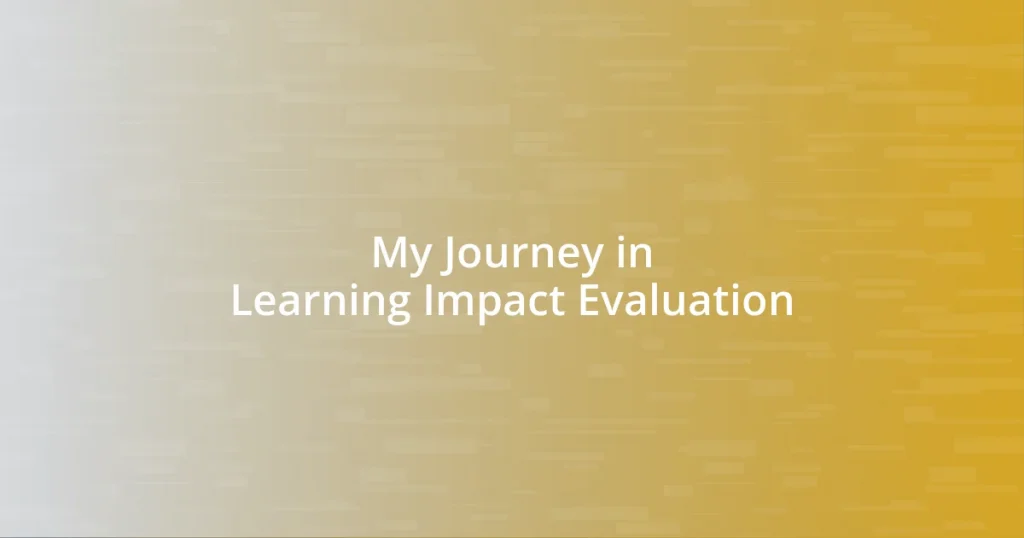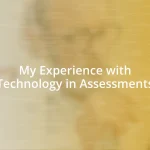Key takeaways:
- Impact evaluation distinguishes between outputs and true outcomes, emphasizing the importance of long-term tracking and qualitative insights alongside quantitative data.
- Learning evaluations enhance educational programs by identifying success factors, targeting improvement areas, engaging stakeholders, and supporting data-driven decision-making.
- Key components of effective evaluations include defined goals, robust data collection methods, and feedback loops, which foster continuous improvement and community engagement.

Understanding Impact Evaluation
Impact evaluation is essentially about understanding the real-world effects of a program or intervention. I vividly remember the first time I dived into a project that aimed to improve educational outcomes in underprivileged communities. The results were fascinating but also heartbreaking; it made me realize how crucial it is to distinguish between mere outputs—like the number of books distributed—and true outcomes, such as improved literacy rates.
When I reflect on this, I often wonder: how can we measure the true impact of our efforts? It’s a complex puzzle that demands not just data collection, but also a thoughtful interpretation of that data. For instance, during my own learning journey, I discovered that surveys and interviews could unveil the emotional and social shifts brought about by an initiative, which numbers alone might not reveal.
Moreover, the timeline of an impact evaluation can be quite revealing. Initially, I overlooked the importance of long-term tracking, but I learned that some impacts unfold slowly, requiring patience and persistence. Understanding this has reshaped my approach to evaluation; I now eagerly look to see how short-term successes contribute to lasting change, reminding myself and my team that true impact is often a marathon, not a sprint.

Importance of Learning Evaluations
Learning evaluations play a pivotal role in shaping effective educational programs. I remember a project I was involved in that sought to enhance teaching methods in local schools. Initially, I focused solely on participant feedback, but soon realized that evaluations also gave me insights into the educators’ growth. This dual perspective strengthened not only the program itself but also my understanding of how nuanced learning can be.
Here are a few key benefits of learning evaluations:
- Identifying Success Factors: Evaluations help pinpoint what works well, enabling us to replicate effective strategies in the future.
- Targeting Improvement Areas: They reveal aspects of a program that may need fine-tuning, ensuring resources are allocated efficiently.
- Engaging Stakeholders: Sharing evaluation results fosters transparency and builds trust among all parties involved, from educators to the community.
- Enhancing Decision-Making: Accurate evaluations provide the necessary evidence to support data-driven decisions and policy formulations.
Reflecting on this, I learned firsthand that evaluations aren’t just numbers—they tell the story of human experience and change, reminding me to look beyond the surface.

Key Components of Impact Evaluations
Understanding the key components of impact evaluations has transformed the way I approach projects. One fundamental aspect is the clear articulation of the program’s goals. Without well-defined objectives, it feels like charting a course without a map. I recall working on a community health initiative where we spent weeks refining our goals. By aligning our evaluation metrics with these goals, we clearly identified what success would look like, ensuring that our efforts were focused and measurable.
Another essential component is establishing a robust data collection process. I remember a project aimed at increasing access to technology in rural schools. We gathered both qualitative and quantitative data—surveys, focus groups, and even classroom observations. This multidimensional approach allowed us to paint a full picture of how the initiatives were received. It became evident that numbers alone couldn’t tell the story; personal testimonies from the teachers and students revealed the emotional and practical impact of our interventions. They highlighted the joy in kids’ eyes when they first touched a tablet, a reminder that behind every statistic is a real-life experience.
Finally, incorporating a feedback loop is vital for continuous improvement. While working on an environmental initiative, we created opportunities for participants to share their experiences regularly. This ongoing dialogue was instrumental in adapting our approach based on real-time feedback, ensuring the project remained relevant and effective. I found that this openness not only engaged the community but also fostered a sense of ownership, making the evaluation process a shared journey rather than a one-sided assessment.
| Component | Description |
|---|---|
| Defined Goals | Clear objectives guide the evaluation process and success measurement. |
| Data Collection | Using a combination of qualitative and quantitative methods to gather comprehensive insights. |
| Feedback Loop | Incorporating participant feedback for ongoing improvements and adaptations. |

Approaches to Conducting Evaluations
Evaluating programs can be approached through various methodologies, each providing unique insights. For instance, I vividly recall an evaluation I conducted using a mixed-methods approach. By blending qualitative interviews with quantitative surveys, I uncovered layers of participant experience that numbers alone couldn’t convey. It was fascinating to see how personal stories could illuminate the effectiveness of our educational initiatives, allowing me to connect with the community on a deeper level.
I’ve also experimented with participatory evaluation, which genuinely transformed the dynamics of my projects. I remember one instance where I invited stakeholders to actively participate in the evaluation design. Their input not only enriched the evaluation process but also created a sense of ownership among them. This collaborative effort raised questions about what truly mattered to them, and those concerns shaped our evaluation focus like never before. It’s remarkable how involving diverse voices can lead to richer, more relevant findings.
Another approach I’ve found effective is the use of case studies. When I worked on a literacy campaign, I decided to delve deeper into individual success stories. By documenting specific cases, I was able to reflect on the broader implications of our efforts. Did you know that a single student’s journey can echo the struggles of an entire community? Through these narratives, I not only demonstrated impact but also helped ensure that the evaluation was not just an afterthought. It became a compelling tool for advocacy, driving home the message that every achievement, no matter how small, contributes to the larger educational landscape.

Challenges in Impact Evaluation
In my experience, one of the most significant challenges in impact evaluation is the difficulty in isolating the effects of the intervention from confounding factors. For instance, I once evaluated a job training program. While many participants reported increased employment rates, I couldn’t help but wonder how much of that success was due to broader economic changes or family support. It made me realize how essential it is to consider external influences when interpreting results.
Another hurdle I’ve faced pertains to the quality and reliability of data collection. I remember a scenario where we relied on self-reported data for a health survey, and it raised flags. Participants might not always provide accurate information due to various biases or fear of stigma. I often find myself asking, how can we trust the data if it’s influenced by personal perceptions? These nuances remind me of the need to be adaptable and cautious when interpreting findings.
Finally, engaging stakeholders throughout the evaluation process can be quite challenging. During one project, I sought feedback from community members, only to discover varied opinions on what constituted success. Some valued quantitative results, while others placed more importance on personal stories of change. This dichotomy made me ponder, how do we balance differing perspectives to paint a complete picture of impact? It became clear that fostering open communication is paramount, yet it’s a delicate dance to understand and incorporate diverse viewpoints.

Tools for Impact Evaluation
When it comes to tools for impact evaluation, I’ve found that surveys remain a staple in quantifying outcomes. I recall using online survey platforms for a youth mentorship program, which streamlined data collection immensely. The real magic happened when I analyzed the results; seeing how specific mentorship aspects correlated with improved self-esteem in participants was both satisfying and eye-opening. Isn’t it incredible how structured questions can unveil the success of a program?
Another tool I’ve often turned to is logic models. I vividly remember a collaborative session where we crafted a logic model outlining our program’s goals and expected outcomes. As we mapped out the connections between resources, activities, and objectives, it brought clarity to our overall strategy. I realized how this visual representation acted as a roadmap, guiding our evaluation while keeping our team aligned. Have you ever experienced a moment where a simple diagram shifted your entire perspective?
Lastly, I can’t overlook the value of case management software in tracking participant progress. During a community health initiative, we implemented a system that allowed us to log interactions and follow up on participant outcomes efficiently. It became a treasure trove of insights, helping us detect trends over time. It made me think—how often do we overlook the potential of digital tools in our pursuit of impactful evaluation? Integrating such technology has certainly changed my approach to understanding impact more comprehensively.

Reflecting on My Learning Journey
Reflecting on my learning journey has been nothing short of transformative. I vividly recall a moment when I stumbled upon a nuanced critique of a project I led. It stung at first, but instead of becoming defensive, I took a step back and reflected. That experience taught me that vulnerability in learning is vital; it opens the door to growth. Isn’t it fascinating how sometimes our biggest setbacks can become our most valuable lessons?
As I delved deeper into the world of impact evaluation, I found myself grappling with the concept of empathy in data analysis. One day, as I analyzed community feedback, I noticed the emotion behind the numbers—stories of struggle, hope, and triumph. This revelation made me realize that behind every statistic is a person with a unique story. How can we truly evaluate impact if we forget the human element? That moment redefined my perspective, pushing me to weave empathy into my evaluations.
In more recent experiences, I have embraced collaboration as a cornerstone of my learning. I remember sitting in a circle with colleagues, sharing our evaluation failures and successes. The camaraderie made me comfortable enough to be honest about my own missteps, which unexpectedly led to a brainstorming session filled with creative solutions. It struck me that reflection, when shared, has the power to catalyze collective growth. Have you ever found that the simple act of sharing challenges can turn into a powerful learning moment?















